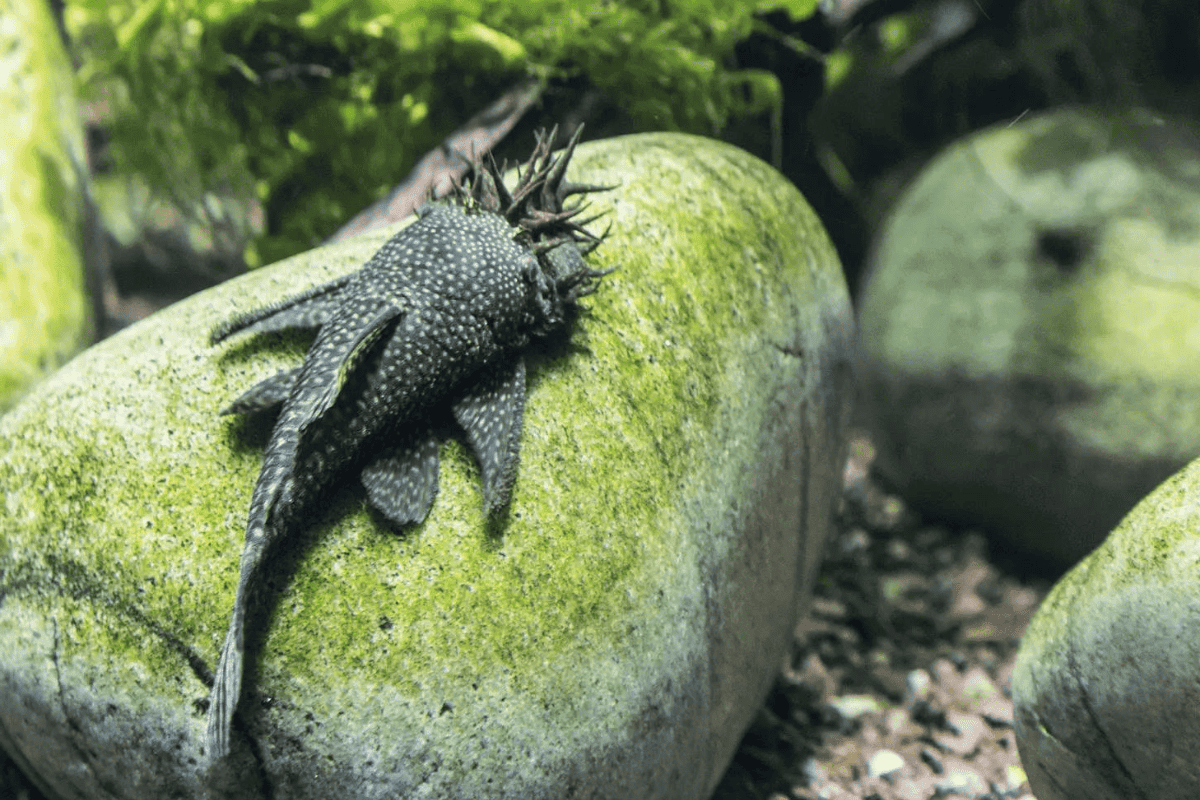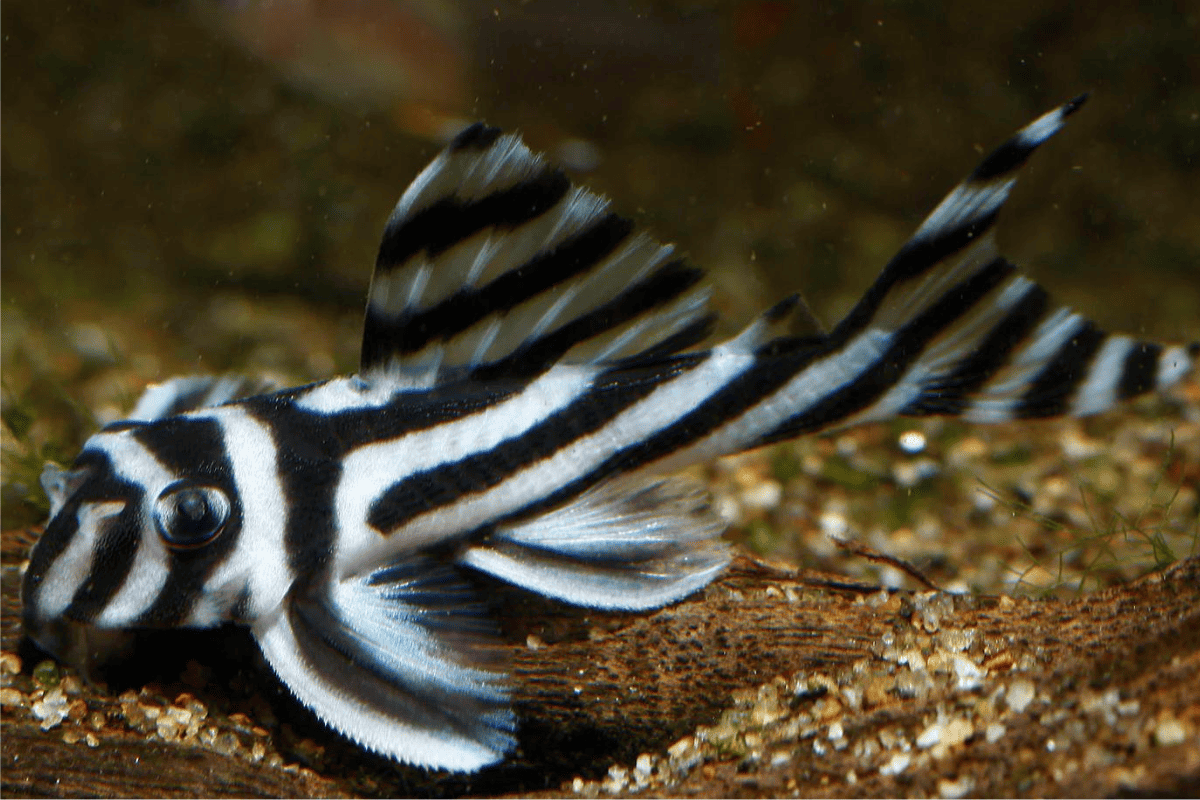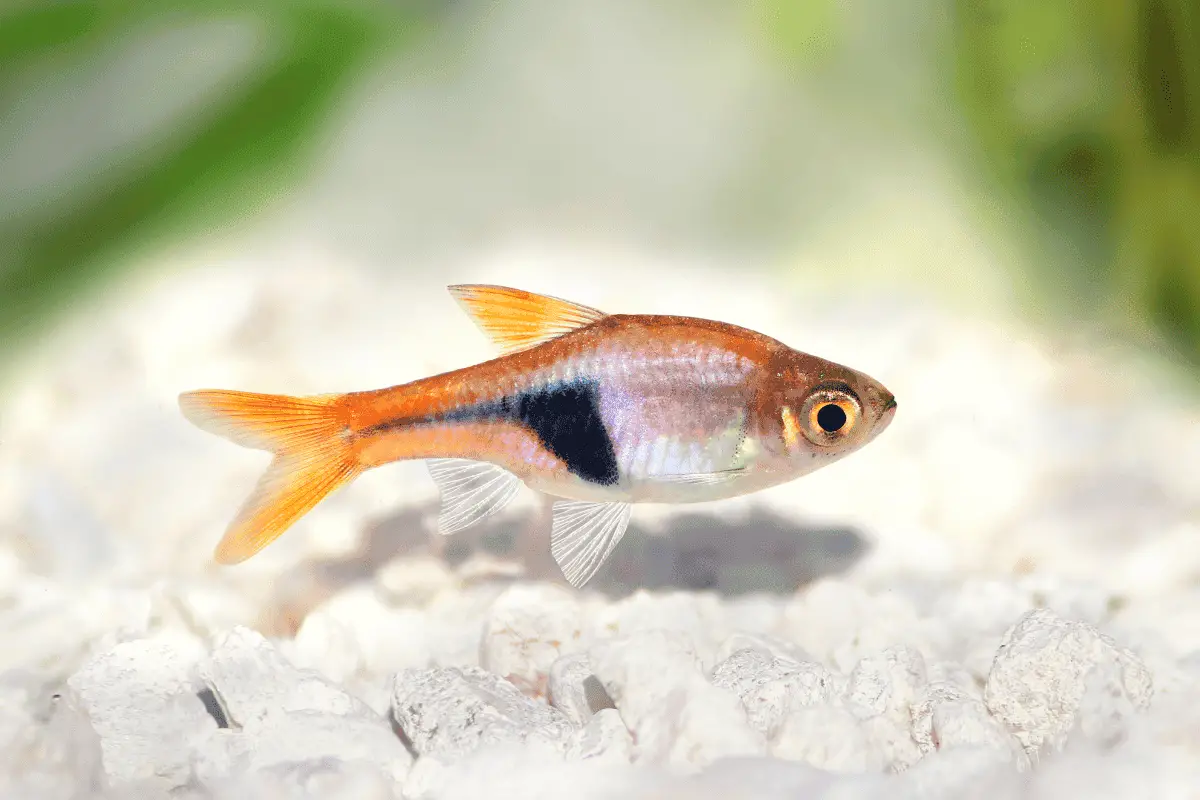Both Plecos and Molly fish are popular choices for home aquariums.
But can they coexist in one tank? How about their water requirements? What’s their behavior like together? And what about their diet?
In this article, I’ll address these questions and more, so you’ll have all the information you need. Let’s jump in.

Can I Keep Plecos and Mollies Together in the Same Tank?
Yes, Plecos and Mollies can coexist harmoniously in the same tank. Their compatibility arises from several key factors:
- Dietary Non-Competition: Plecos are mainly herbivores focusing on algae, while Mollies have a more varied diet. This means they won’t often compete for food sources.
- Distinct Habitats: Plecos are bottom dwellers and love to hide, whereas Mollies are active mid-tank swimmers, so they occupy different tank regions.
- Similar Environment Preferences: Both species prefer temperatures between 72-78°F and a pH of 6.5 to 7.5, making tank conditions suitable for both without major adjustments.
- Peaceful Temperaments: Neither Plecos nor Mollies are typically aggressive, so they don’t pose threats to each other, ensuring a serene tank atmosphere.
- Low Territorial Conflicts: As Plecos spend much of their time at the bottom and Mollies swim higher up, territorial disputes are minimal between these species.
Also Read: Pleco Fish Tank Mates
Plecos vs. Mollies: Behavior
When diving into the natural behaviors of Plecos and Mollies, there are some interesting distinctions to note:
Pleco Fish: Natural Behavior
Here’s a quick overview of what Plecos are like in their natural habitat:
- Bottom Dwellers: Plecos are intriguing creatures that typically hang out at the bottom of the tank, munching on algae with their sucker mouths.
- Night Owls: These fish are most lively after dark, so you might catch them at their most active when the lights are off.
- Territorial Streak: Generally easy-going, Plecos can become protective over certain tank zones, especially when it involves hiding places or food.
- Distinct Traits: Recognizable by their armored plates and flattened bodies, Plecos are built to cling to and glide along surfaces.

Molly Fish: Natural Behavior
Here’s the lowdown on what to expect from Mollies in their natural setting:
- Lively Swimmers: Mollies are energetic, often zipping through the middle and upper sections of the tank, flashing their bright hues.
- Group Lovers: Social by nature, Mollies prefer to swim in groups and might cluster, especially if they sense danger.
- Varied Eaters: Mollies have a diverse palate, enjoying plants but also munching on tiny insects and crustaceans.
- Breeding Habits: As livebearers, Mollies produce live offspring instead of laying eggs. This can lead to a growing tank family if you’re not careful.

Ideal Parameters for Plecos and Mollies
If you’re looking to create a perfect home for Plecos and Mollies in your aquarium, it’s essential to master the water parameters.
Here’s a handy comparison to ensure both fish types thrive, especially if you’re keeping them together:
| Parameter | Plecos | Mollies | Both Types |
| Temperature | 74°F – 80°F | 72°F – 78°F | 75°F – 78°F |
| pH Level | 6.5 – 7.5 | 7.5 – 8.5 | 7.0 – 8.0 |
| Water Hardness | 4 – 15 dGH | 10 – 25 dGH | 10 – 15 dGH |
Pleco Fish: Ideal Parameters
For Plecos to thrive, they require specific water conditions that align with their natural habitats.
Adjusting and maintaining these parameters ensures the health and longevity of Plecos.
- Temperature: Plecos prefer water temperatures ranging from 72-78°F (22-25°C), which resembles their tropical origin.
- pH Level: A pH range of 6.5 to 7.5 is ideal for Plecos, maintaining a slightly acidic to neutral water environment.
- Water Hardness: Plecos are adaptive but generally enjoy moderately soft to slightly hard water, with hardness values between 6-15 dGH.

Molly Fish: Ideal Parameters
Mollies are vibrant fish that also hail from tropical environments, but they do have certain distinctions in their water requirements when compared to Plecos.
- Temperature: Mollies thrive in slightly warmer conditions, with an optimal temperature range of 77-82°F (25-28°C).
- pH Level: They prefer slightly alkaline water, so a pH of 7.5 to 8.5 is best suited for Mollies, ensuring they remain energetic and vibrant.
- Water Hardness: Mollies need harder water conditions, ideally between 10-25 dGH, to replicate their natural habitat conditions.

Plecos vs. Mollies: Tank Setup
Setting up the right environment is essential for the health and happiness of Plecos and Mollies.
Here’s a comparative look at tank setup requirements for each fish and considerations for a tank with both:
| Setup Aspect | Plecos | Mollies | Both Types |
| Ammonia | Near 0 ppm | Near 0 ppm | Near 0 ppm |
| Nitrite | Near 0 ppm | Near 0 ppm | Near 0 ppm |
| Nitrate | Below 30 ppm | Below 40 ppm | Below 35 ppm |
| Tank Size | Minimum 40 gallons | 10-20 gallons | Minimum 50 gallons |
| Foliage | Loves live plants | Prefers live plants | Mix of plants |
| Decorations | Requires caves | Open swim spaces | Combination of both |
| Filter | Strong filtration | Moderate filtration | Strong filtration |
| Heater | Essential | Often not required | Essential |
| Substrate | Fine gravel/sand | Fine gravel/sand | Fine gravel/sand |
| Pump | Moderate flow | Gentle flow | Moderate flow |
| Lighting | Moderate | Moderate to bright | Moderate |
Pleco Fish: Tank Setup
Setting up a tank for Plecos requires attention to detail to replicate their natural habitat and accommodate their specific needs.
Since Plecos can grow large and have unique behaviors, their environment should reflect this.
- Ammonia Nitrite Nitrate: Plecos are sensitive to water quality, so levels of ammonia, nitrite, and nitrate should be kept minimal. Regular water changes and good filtration can help.
- Tank Size: Given that some Pleco species can grow up to 24 inches, a minimum of 55 gallons is recommended, with larger species requiring 125 gallons or more.
- Foliage: Plecos enjoy tanks with plenty of live plants that can offer additional food sources and hiding places.
- Decorations: Include caves, driftwood, and rocks to offer Plecos hiding spots and territories to claim.
- Filter: A robust filter, preferably a canister type, is essential to handle Pleco waste and maintain water clarity.
- Heater: Maintain the temperature at 72-78°F, so a reliable heater is crucial.
- Substrate: Sand or fine gravel works well for Plecos, providing a natural substrate to rummage through.
- Pump: A moderate flow pump, mimicking river environments, would be best for Plecos.
- Lighting: Plecos are less concerned about lighting, but dimmer lighting might mimic their natural shaded riverbed habitat.

Molly Fish: Tank Setup
Mollies are active swimmers with vibrant colors and have their own set of tank preferences to showcase their beauty and keep them thriving.
- Ammonia Nitrite Nitrate: Just like Plecos, Mollies also need pristine water. Keep these parameters in check to ensure Molly health.
- Tank Size: A minimum of 20 gallons is recommended for Mollies due to their active nature, but larger is always better.
- Foliage: They appreciate well-planted tanks which offer hiding spots, resting areas, and added aesthetic appeal.
- Decorations: Mollies enjoy open swimming areas, so while decorations are good, don’t overcrowd the tank.
- Filter: A good filter will help in removing debris and keeping the water clear. Hang-on-back or sponge filters work well for Mollies.
- Heater: With a preference for 77-82°F, Mollies require a heater to maintain this tropical temperature.
- Substrate: Fine gravel or sand, which allows for plant rooting, is ideal for Molly tanks.
- Pump: A mild to moderate flow is best for Mollies to mimic their natural habitat without causing stress.
- Lighting: Brighter lighting can showcase the vibrant colors of Mollies and support plant growth in the tank.

The Dietary Requirements of Plecos and Mollies
Catering to the dietary needs of Plecos and Mollies ensures their health and vibrant colors.
This table offers a glance at the preferred diets of each fish and a blended approach for a shared environment:
| Dietary Aspect | Plecos | Mollies | Both Types |
| Food Types | Algae wafers, vegetables | Flake food, live food | Mix of both diets |
| Quantity | Depends on size, 1-3 wafers/day | Small amounts daily | Varied, observe and adjust |
| Feeding Schedule | Once daily, evening | 2-3 times daily | Balance to avoid overfeeding |
Pleco Fish: Ideal Dietary Requirements
Plecos, being primarily herbivores, have a preference for plant-based diets, but they can consume a variety of foods.
Providing a balanced diet is critical for their health, coloration, and growth.
- Food Types: Plecos relish algae wafers, vegetables like zucchini or cucumber, and occasional protein sources like bloodworms or brine shrimp.
- Quantity: Depending on their size, Plecos might eat a sizable algae wafer or a couple of slices of vegetables daily. Ensure uneaten food is removed to prevent water pollution.
- Feeding Schedule: Feeding Plecos once a day, preferably in the evening due to their nocturnal habits, ensures they get their nutrition when most active.

Molly Fish: Ideal Dietary Requirements
Mollies are omnivorous, enjoying a mix of both plant and protein-based foods. This diversity ensures they receive all necessary nutrients for vibrant colors and energetic behavior.
- Food Types: A mix of flake food, vegetable tablets, and live or frozen foods like brine shrimp or daphnia is ideal for Mollies.
- Quantity: Mollies should be fed only what they can consume in about 2-3 minutes to prevent overfeeding and tank pollution.
- Feeding Schedule: For optimum health, feeding Mollies small amounts twice daily helps mimic their natural grazing behavior.

Pleco Species Most Suitable for a Tank With Mollies
When choosing Plecos for a tank with Mollies, it’s wise to opt for species that remain smaller in size and are peaceful by nature.
This ensures compatibility and reduces potential territorial disputes.
- Bristlenose Plecos (Ancistrus spp.): Typically growing to 4-6 inches, these Plecos are ideal for community tanks and don’t disturb Mollies.
- Clown Pleco (Panaqolus maccus): This species stays small, reaching about 3-4 inches, and is known for its vibrant patterns and peaceful demeanor.
- Rubber Lip Pleco (Chaetostoma formosae): A gentle species, they grow to about 7 inches and primarily focus on algae, posing no threat to Mollies.
- Zebra Pleco (Hypancistrus zebra): A sought-after species due to its striking appearance, the Zebra Pleco grows up to 3-4 inches and is non-aggressive.
- Dwarf Pleco (Parotocinclus sp.): As the name suggests, these Plecos stay small, typically around 2 inches, making them compatible tank mates for Mollies.
Also Read: Can Plecos And Platies Live Together?

Pleco Types to Avoid Keeping with Mollies
Some Pleco species can grow substantially large or exhibit aggressive behavior, making them unsuitable for community tanks with Mollies.
- Common Pleco (Hypostomus plecostomus): At a length of up to 24 inches, these Plecos can overshadow a tank and may accidentally intimidate or stress Mollies.
- Sailfin Pleco (Pterygoplichthys gibbiceps): This large species, reaching up to 20 inches, might be too overwhelming in a tank populated by Mollies.
- Vampire Pleco (Leporacanthicus galaxias): Recognized for their distinct look, these Plecos can be territorial, showing aggression to other tank residents.
- Panaque Plecos: Wood-eating Plecos like the Royal Pleco can grow substantially and exhibit dominant behaviors, which might be problematic for Mollies.
- Adonis Pleco (Acanthicus adonis): With a growth potential of an astonishing 40 inches, they are unfit for community tanks, posing a threat to smaller Mollies.
Guidelines for Adding Your Pleco to a Mollies’ Tank
Introducing a Pleco to a Mollies’ tank needs thoughtful preparation to guarantee a stress-free adjustment for both fish types.
A step-by-step and observed method ensures a harmonious introduction.
- Acclimatization: Start by allowing the Pleco’s bag to float in the tank for about 30 minutes to balance the water temperatures.
- Water Mixing: Gradually mix small quantities of the tank water into the Pleco’s bag over the next 30 minutes to familiarize them with water conditions.
- Optimal Timing: It’s best to introduce your Pleco in the evening, a time they’re naturally active, to reduce initial stress and possible conflicts.
- Shelter Provisions: Ensure you have enough caves, driftwood, and ornaments in the tank before adding the Pleco. This provides them places to hide and feel safe.
- Observation is Key: Post-introduction, keep an eye on both the Mollies and Pleco, watching for any aggression or stress, and be prepared to make adjustments if needed.

Tips for Keeping Plecos with Mollies
Keeping Plecos with Mollies can be harmonious with the right care and knowledge. To maximize their coexistence, it’s essential to follow specific practices.
- Tank Size: Opt for a minimum of 40 gallons; Plecos need space to grow, and Mollies love open swimming areas.
- Diverse Diet: Feed Plecos zucchini slices twice a week; for Mollies, provide flake food daily with occasional brine shrimp.
- Hideouts and Terrain: Offer multiple caves or driftwood pieces; Plecos need hiding spots, while Mollies appreciate plants like Java fern. My recommendation: Dr. Moss Malaysian Driftwood (link to Amazon).
- Regular Water Checks: Test water bi-weekly, ensuring ammonia and nitrites are near zero and nitrates below 20 ppm.
- Maintain Water Parameters: Keep a steady temperature of 75-80°F, with a pH of 6.5-8, catering to both species’ needs.
- Avoid Overcrowding: Limit to one Pleco for every 40 gallons and 3-4 Mollies for every 10 gallons to prevent territorial disputes.
- Observe and Adjust: Monitor interactions daily; if a Pleco becomes too territorial, consider rearranging the tank’s setup or adding barriers.
Best Tank Mates for Plecos and Mollies
Plecos and Mollies are generally peaceful and can coexist with a variety of tank mates, given the right conditions and size of the tank.
Selecting tank mates that have similar water requirements and temperaments can lead to a harmonious aquatic community.
- Corydoras Catfish: These bottom dwellers, gentle by nature, can coexist with Plecos, often sharing the tank floor without issues.
- Guppies: Being peaceful livebearers like Mollies, Guppies can mingle and even breed, adding vibrancy to the tank.
- Dwarf Gouramis: With their calm demeanor, these fish can cohabitate without disturbing the Plecos or overshadowing the Mollies.
- Rasboras: Species like Harlequin Rasboras can peacefully swim mid-tank, complementing both Mollies and Plecos in activity and appearance.
- Snails and Shrimp: Invertebrates like Mystery Snails and Cherry Shrimp not only help in tank maintenance but are also friendly tank mates for Plecos and Mollies.
- Tetras: Schools of tetras, like Neon or Cardinal Tetras, add color and energy without posing a threat to Plecos or Mollies.
Also Read: Can Plecos And Neon Tetras Live Together?

Conclusions
For the quick readers, here’s a brief summary:
- Plecos and Mollies can thrive together in one tank, thanks to their different diets, unique living zones, and shared habitat preferences.
- Recognizing the Plecos’ tendency to stay at the tank’s bottom and Mollies’ active swimming patterns is fundamental for a balanced tank.
- Consistent water conditions, including temperature and pH, play a pivotal role in ensuring both Plecos and Mollies are healthy in a communal setting.
- Crafting the right tank environment—with the correct tank size, decorative elements, and filtration—is pivotal for the well-being of both species.
- Selecting the right Pleco species and introducing them cautiously is essential to prevent any clashes when housing them with Mollies.
